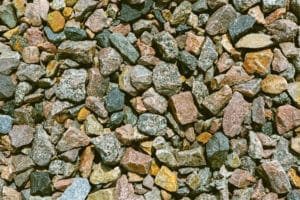What is Drain Rock & How Is It Used?
 Drainage Rock is one of the oldest, simplest, and most useful resources available to landscape architects today. Though we may never really think about it, there is a huge variety of stone materials, shapes, and styles that can be used in endless building applications.
Drainage Rock is one of the oldest, simplest, and most useful resources available to landscape architects today. Though we may never really think about it, there is a huge variety of stone materials, shapes, and styles that can be used in endless building applications.
One style of stone that builders and homeowners depend on is drain rock. Rather than its size or shape, drain rock is primarily identified by its purpose– as the name suggests, drain rock is a porous gravel material designed to manage the flow of water in a drain.
Common Drain Rock Features
This style of stone comes in a few common sizes: 1 1/2 inch, 3/4 inch, 7/8 inch, or 3/8 of an inch. This smallest size is sometimes called pea gravel as well. These stones can come in rough, jagged varieties, or be smooth in texture, depending on the builder’s preference and their intended application.
Additionally, drain rock color can range as widely as the color of stone, from white to black to different shades of grayish-blue. Often, the color of drain rock will depend on the location of the quarry it came from.
Common Drain Rock Applications
Drain rock is valued for its use in many different drainage techniques. Here are just a few examples of water management and redirection that utilize drain rock:
- French Drains: A French drain is a style of trench that contains a perforated pipe. The trench or hole is filled with drain rock, which allows water to easily flow towards the pipe for redirection. French drains are essential for protecting building foundations from water damage.
- Driveways: Drain rock is sometimes used to line and support paved driveways. When used beneath and around asphalt or concrete, drain rock quickly absorbs runoff water that flows from the impermeable pavement. Since topsoil (the uppermost layer of dirt) is between two and eight inches thick, it doesn’t always absorb rain quickly. Drain rock near driveways can help prevent flooding when topsoil has become saturated.
- Gardening: Finally, gardeners value drainage rock for its ability to prevent soil erosion when used as a mulch. Additionally, drain rock can provide a base layer for garden beds that prevents roots from becoming over-hydrated.
Though a simple tool, drain rock is surprisingly useful. From gardening to construction, crafters of all kinds value its ability to divert and control the flow of water.
If you’re looking for drain rock, washed gravel, or utility sand in the Seattle area, contact Builders Sand and Gravel today!
